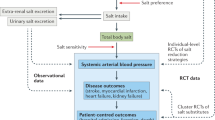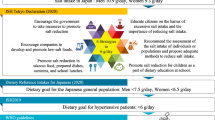Abstract
A colony of 26 chimpanzees given a fruit and vegetable diet of very low Na and high K intake were maintained in long–standing, socially stable small groups for three years. Half of them had salt added progressively to their diet during 20 months. This addition of salt within the human dietetic range caused a highly significant rise in systolic, mean and diastolic blood pressure. The change reversed completely by six months after cessation of salt. The effect of salt differed between chimpanzees, some having a large blood pressure rise and others small or no rise. These results in the species phylogenetically closest to humans bear directly on causation of human hypertension, particularly in relation to migration of preliterate people, with low Na diet, to a Western urban lifestyle with increased salt intake. The hedonic liking for salt and avid ingestion was apt during human prehistory involving hunter–gatherer–scavenger existence in the interior of continents with a scarcity of salt, but is maladaptive in urban technological life with salt cheap and freely available.
This is a preview of subscription content, access via your institution
Access options
Subscribe to this journal
Receive 12 print issues and online access
$209.00 per year
only $17.42 per issue
Buy this article
- Purchase on Springer Link
- Instant access to full article PDF
Prices may be subject to local taxes which are calculated during checkout
Similar content being viewed by others
References
MacGregor, G. Sodium is more important than calcium in essential hypertension. Hypertension 7, 628–640 (1985).
Dahl, L.K. Salt and hypertension. Am. J. Clin. Nutr. 25, 231–244 (1972).
Simpson, F.O. Salt and hypertension: A skeptical review of the evidence. Clin. Sci. 57, 463S–480S (1979).
Altschul, A.M. & Groment, J.K. Sodium intake and sodium sensitivity. Nutr. Rev. 38, 393–402 (1980).
Freis, E.D., Salt, volume and the prevention of hypertension. Circulation 53, 589–595 (1976).
Swales, J. Dietary salt and hypertension. Lancet i, 1117–1179 (1980).
Swales, J.D. Salt saga continued. Salt has only small importance in hypertension [Editorial]. Br. Med. J. 297, 307–308 (1988).
Rose, G. & Stamler, J. The INTERSALT study: Background, methods and main results. J. hum. Hypertens. 3, 283–288 (1989).
McCarron, D.A., Morris, C.D., Henry, H.J. & Stanton, J.L. Blood pressure and nutrient intake in the United States. Science 224, 1392–1398 (1994).
Hanneman, R.L. The politics of sodium restriction in the United States. 7th Symposium on Salt II, 231–239 (Elsevier Science, Amsterdam, 1993).
Brown, J.J. et al. Salt and hypertension. Lancet ii, 456 (1984)
Denton, D. The Hunger for Salt: An Anthropological, Physiological and Medical Analysis (Springer, Berlin, 1982).
Denton, D. Hypertension: A malady of civilization? in Systemic Effects of Antihypertensive Agents (ed. Sambhi, M.P.) 577–583 (Symposia Specialists, New York, 1976).
Gliebermann, L. Blood pressure and dietary salt in human populations. Ecol. Food Nutr. 2, 143–156 (1973).
Trowell, H.C. From normotension to hypertension in Kenyans and Ugandans. East Africa Med. J.. 57, 167–173 (1980).
Laragh, J.H. & Pecker, M.S. Dietary sodium and essential hypertension: Some myths, hopes and truths. Ann. intern. Med. 98, 735–743 (1983).
Poulter, N.R. & Sever, P.S. Low blood pressure populations and the impact of rural-urban migration. in Textbook of Hypertension (ed. Swales, J.) 22–36 (Blackwell Scientific, Oxford, 1994).
Poulter, N.R., Khaw, K.T., Mugambi, M., Peart, W.S. & Sever, P.S. Migration-induced changes in blood pressure: A controlled longitudinal study. Clin. exp. Pharm. Physiol. 12, 211–216 (1985).
Poulter, N.R. et al. The Kenyan Luo migration study: Observations on the initiation of a rise in blood pressure. Br. Med. J. 300, 967–972 (1990).
Pickering, G.W. Salt intake and essential hypertension. Cardiovasc. Rev. Rep. 1, 1–7 (1980).
Page, L.B., Damon, A. & Moellering, R.C. Jr., Antecedents of cardiovascular disease in six Solomon Islands society. Circulation 49, 1132–1146 (1974).
Truswell, A.S., Kennelly, B.M., Hansen, J.D.L. & Lee, R.B. Blood pressure of !Kung bushmen in Northern Botswana. Am. Heart. J. 84, 5–12 (1972).
Sinnett, P.F. & Whyte, H.M. Epidemiological studies in a total highland population, Tukisenta, New Guinea. Cardiovascular disease and relevant clinical, electrocardiographic, radiological and biochemical findings. J. chron. Dis. 26, 265–290 (1973).
Oliver, W.J., Cohen, E.L. & Neel, J.B. Blood pressure, sodium intake and sodium related hormones in the Yanamamo: A ‘no salt’ culture. Circulation 52, 146–151 (1975).
Oliver, W.J., Neel, J.V., Giekin, R.J. & Cohen, E.L. Hormonal adaptation to the stresses imposed upon sodium balance by pregnancy and lactation in the Yanamamo Indians, a culture without salt. Circulation 63, 110–116 (1981).
Takahashi, B. An epidemiological approach to the relation between diet and cardiovascular lesions and arteriosclerotic heart disease. Tohoku J. ext. Med. 77, 239–250 (1962).
Sasaki, N. High blood pressure and the salt intake of the Japanese. Jpn. Heart J. 3, 313–324 (1962).
Maddocks, I. Blood pressure in Melanesians. Med. J. Australia 20, 1123–1125 (1967).
Eichberg, J.W. & Shade, R.E. “Normal” blood pressure in chimpanzees. J. Med. Primatol. 16, 317–321 (1987).
Rose, B.D. Pathophysiology of Renal Disease 4 (McGraw-Hill, New York, 1981).
Yamori, Y. Hypertensive cardiovascular diseases: Importance of nutrition in pathogenesis and prevention. in Third International Conference on Nutrition in Cardiovascular Diseases. Ann. N.Y. Acad. Sci. 676, 92–104 (1993).
Kawasaki, T., Delea, C.S., Bartter, F.C. & Smith, H. The effect of high sodium and low sodium intakes on blood pressure and other related variables in human subjects with idiopathic hypertension. Am. J. Med. 64, 193–196 (1978).
Shimkets, R.A. et al. Liddle's syndrome: Heritable human hypertension caused by mutations in the β subunit of the epithelial sodium channel. Cell 19, 407–414 (1994).
Leckie, B. & Norman, R. A direct link to salt. Curr. Biol. 5, 260–261 (1995).
Changnon, N. Yanamamo: The Fierce People (Holt, Rinehart and Winston, New York, 1977).
Kaplan, N.M. Clinical Hypertension (4th edn) 70 (Williams and Wilkins, Baltimore, 1984).
Folkow, B. Salt and hypertension. News Physiol. Sci. 5, 220–224 (1990).
WoldeGabriel, G. et al. Ecological and temporal placement of early Pliocene ho-minids at Aramis, Ethiopia. Nature 371, 330–333 (1994).
Coppens, Y. East side story: The origin of human kind. Sci. Am. 270, 88–95 (1994).
The First Humans. The American Museum of Natural History, vol. 1. 46, 54, 65 (Harper Collins, San Francisco, 1993).
Clark, J.D. The Prehistory of Africa (Praeger, New York, 1970).
Issac, G. The diet of early man. World Archeol. (Feb), 278 (1971).
Buss, D.H. Mammary glands and lactation. in Comparative Reproduction of Nonhuman Primates (ed. Hafez, E.S.E.) 315–333 (Thomas, Springfield, Illinois, 1971).
O'Dea, K. Diabetes in Australian aborigines: Impact of the Western diet and lifestyle. J. intern. Med. 232, 103–117 (1992).
O'Dea, K. Traditional diet and food preferences of Australian aboriginal hunter-gatherers. Phil. Trans. R. Soc. London B334, 233–241 (1991).
O'Dea, K. Obesity and diabetes in “the land of milk and honey”. Diabetes/Metabol. Rev. 8, 373–388 (1992).
Eaton, S.B. & Konner, M. Paleolithic nutrition: A consideration of its nature and current implications. New Engl. J. Med. 312, 283–289 (1985).
Stamler, J. Dietary salt and blood pressure. in Third International Conference on Nutrition in Cardiovascular Diseases (eds Lee, K.T., Oike, Y. & Kanazawa, T.) Ann. N.Y. Acad. Sci. 676, 122–156 (1993).
Stamler, J. Blood pressure and high blood pressure: Aspects of risk. Hypertension 18, 95–107 (1991).
Hofman, A., Hazebroek, A. & Valkenburg, H. A randomized trial of sodium intake and blood pressure in newborn infants. JAMA 250, 370–373 (1983).
Goobbee, D.E. Sodium and potassium. in Textbook of Hypertension (ed. Swales, J.D.) 539–551 (Blackwell, Oxford, 1994).
Nutrient Requirements of Laboratory Animals, No. 10, Nutrient Requirements of the Monkey (Subcommittee on Laboratory Animal Nutrition 29–45, (Natn. Academy of Sciences, Washington, DC, 1972).
Paul, A. & Southgate, D., The Composition of Foods (eds McCance, R.A. & Widdowson, E.) (HM Stationery Office, London, 1978).
Menard, J. & Catt, K.S. Measurement of renin activity, concentrations and substrate in rat plasma and radioimmunoassay of angiotensin I. Endocrinology 90, 422–430 (1972).
Cushman, D.W. & Cheung, H.S. Spectrophotometric assay and properties of the angiotension-converting enzyme of rabbit lung. Biochem. Pharmacol. 20, 1637–1648 (1971).
Bradford, M.M. A rapid and sensitive method for the quantitation of micro-gram quantities of protein utilizing the principle of protein-dye binding. Anal. Biochem. 72, 248–254 (1976).
Huu, P., Trung, M.T. & Corvol, P. A direct determination of plasma aldosterone using a specific aldosterone antibody. Steroids 24, 587–598 (1974).
Doucet, C., Huby, T., Chapman, J. & Thillet, J. Lipoprotein(a) in the chimpanzee: relationship of Apo(a) phenotype to elevated plasma Lp(a) levels. J. Lipid Res. 35, 263–270 (1994).
Author information
Authors and Affiliations
Rights and permissions
About this article
Cite this article
Denton, D., Weisinger, R., Mundy, N. et al. The effect of increased salt intake on blood pressure of chimpanzees. Nat Med 1, 1009–1016 (1995). https://doi.org/10.1038/nm1095-1009
Received:
Accepted:
Issue Date:
DOI: https://doi.org/10.1038/nm1095-1009
This article is cited by
-
Sodium Homeostasis and Hypertension
Current Cardiology Reports (2023)
-
Salt sensitivity and hypertension
Journal of Human Hypertension (2021)
-
High-salt intake accelerates functional and histological renal damage associated with renal tissue overexpression of (pro)renin receptors and AT1 receptors in spontaneously hypertensive rats
Clinical and Experimental Nephrology (2020)
-
Sodium—not harmful?
Pediatric Nephrology (2020)
-
Is too much salt harmful? Yes
Pediatric Nephrology (2020)



